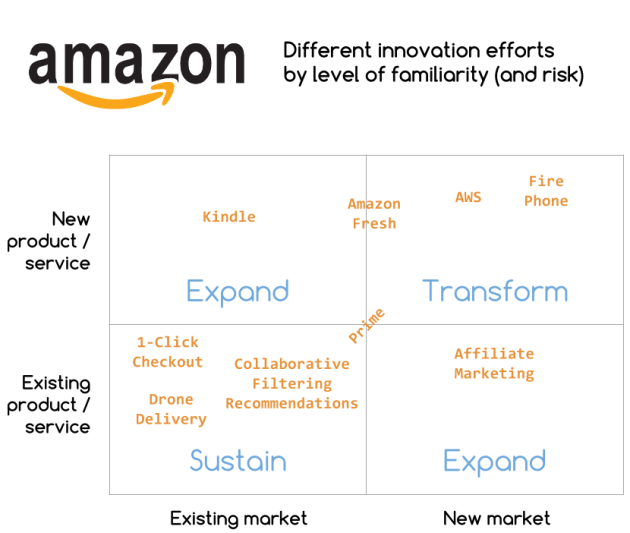In October 2004, Gregg Zeehr, then vice president of hardware engineering at Palm Computing, formed a small team named Lab126 to execute a vision of the Amazon team: to improve upon the physical book. Since then, Lab 126 has become Amazon’s center for innovation, research, and development. Lab126’s name originated from the arrow in the Amazon logo, which draws a line from A to Z in “Amazon.”: the 1 stands for “A” and the “26” stands for “Z.” As stated on Lab126’s website, its vision is “to deliver instant access to everything - digital or physical - from anywhere, via delightfully unique Amazon experiences that make life easier and more fun.” In the words of Xavier Garambois, Vice President of EU Retail at Amazon: “Innovation is part of the Amazon DNA and over the past 15 years we have been constantly adding and refining technology that enhances and improves the experience of all our customers.” Through these early and enduring innovation commitments, Amazon grew from the physical book seller to the e-commerce giant that it is today. Lab126, together with other innovation entities and Amazon departments have introduced many different devices and services that fundamentally changed customer’s behavior, from reading, shopping, web-browsing, watching, to the way we interact with other. Here are a list these notable innovations:
- 2000: Introduction of Marketplace
- 2002: Amazon Web Services
- 2005: Amazon Prime
- 2006: Amazon Fresh
- 2007: Amazon Kindle
- 2008: Amazon Game
- 2010: Amazon Studios
- 2011: Amazon Kindle Fire
- 2013: Amazon Air
- 2014: Amazon Fire Phone & Amazon Echo
A helpful matrix from Cloudave helps organize these innovations into groups:

Source: CloudAve
By 2015, Amazon has invested $10B dollars into R&D and innovation. Facing competitions (with deep pockets) on all sides, we believe it is crucial for Amazon to continue on its innovation investments while staying true to its BHAG: “To be Earth's most customer-centric company” To refine this goal even more for the next 5 years, we believe Amazon should create innovation to support its Prime business, a . Below are our recommendations based on current trends and 5-years trajectory customer behavior adaptation:
Machine will be more helpful through machine learning and data management:
Since its first debut at the beginning 2014, Amazon’s Echo, now better known by its virtual assistant Alexa, has built a whole ecosystem and at least three extension devices. While Echo currently only focuses on a few basic tasks such as reading audible book, checking the weather, playing music, it has instantly built enthusiastic followers by tapping into the human need to interact with other human-like entities. With first-mover advantage, Amazon has forced other competitors into this space. In fact, Google just announced Google Home, a direct competitor to Echo. Without the vast data that Google possess, Echo needs to focus on what Amazon is known for: shopping through Prime. Echo has to become the ultimate personal shopper and friend the entire family can rely on. According to recent reviews, Echo is off to a good start. “Alexa is part of the family.”
Households will be run by the Internet of Things (IoT)
The Amazon Dash button is a simple innovation with a huge potential. These buttons are WiFi enabled, and when pushed, they send a signal to Amazon that automatically reorders the product for your pantry. Convenience has been an important factor in Dash’s success. From December 2015 to March 2016, Amazon announced that Dash Button orders increased by 75%. In fact, they are currently being pressed at a rate of more than one per minute. Together with Echo, Amazon can lay the foundation to a network of IoT that will support it e-commerce platform in every household.
Shopping through wearable
Smart watches, smart jewelry, smart fashion – these are the body extensions that are getting more advanced by the day. When Amazon launched the Fire phone with facial tracking, it has the ambition to allow browsing and selecting merchandises by eye contacts, Jeff Bezos is making a bold move, an attempt to make Amazon more integrated into a person’s life. However, with the wearable market exponential growth (from $20 billion in 2015 to almost $70 billion in 2025), Amazon should make strategic investments and partnerships with external hardware/wearable instead of a renew investment in the Fire phone. Soon enough, we will be able to buy items on Amazon with a swipe on the sleeves, a rotation of the ring, or a tap on the watch.
Invisible forces make the difference
Shipping, delivering, even web hosting – these are support systems which may not be visible to the end-consumers. However, their impact reaches every corner of Prime, from e-commerce to content delivery, to grocery delivery. The Amazon Prime Air program has been testing and building a fleet of drones that could deliver packages weighing up to 2.3kg to customers within 30 minutes of them placing the order. Until April 2016, Amazon Web Services is approaching a $10 billion-a-year business. This exponential growth from Amazon Web Services ensures the trajectory growth for all other Amazon branches, including Prime. Amazon Prime Air, on the other hand, slowly builds the alternative transportation options and gains independence for Amazon from suppliers. With these technology, Amazon can improve the ease and speed of its Prime business services which is why we would recommend Amazon to continue its investment in these support systems.
Amazon CEO Jeff Bozos stated in 2011: “We are stubborn on vision. We are flexible on details…. We don’t give up on things easily” and Amazon is “willing to be misunderstood for a long time”. With these innovation investments, Amazon can continue to grow its Prime business and truly become a customer-centric company.
This opinion piece is part of a larger strategic analysis while at Indiana University. For the full analysis, drop me a note.

